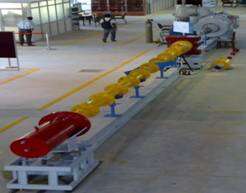The first Indian free piston driven hypersonic shock tunnel (FPST), named HST3, was established about a decade ago in the department of Aerospace Engineering, IISc. It is essentially built using 165 mm diameter compression tube because of the availability of these tubes in the laboratory. The inspiration and the support to build this tunnel came directly from Prof. Ray Stalker during my first meeting with him in 1994 at the International workshop on shock tubes held at UQ, Brisbane. He was very happy with the establishment of HST3 and inspite of his medical problems he visited us on September 11, 2001 which inspired many young researchers. Since its inception HST3, shown in Fig. 1, has become an important research facility in aerodynamics and material science. In addition it has been used as a prototype to design two industrial scale free piston driven shock tunnels to meet the needs of Indian defence and Space Research programs. Since the number of users for aerodynamic research is very large in recent times it has become difficult to find the tunnel time for materials research. Hence we have started assembling one more free piston driven shock tube, shown in Fig. 2, dedicated to non-aerospace applications. Currently many material science researchers in India and abroad are utilizing HST3.
Important research problems investigated in HST3 are the experimental investigation of large number of flow control techniques at hypersonic Mach numbers, scramjet intake studies, force and heat transfer rate measurements for many vehicle configurations, study of catalytic reactions on the thermal protection system materials and blast resistance study of metal and composite plates used for developing the armor plates. Currently we are in the process of converting the HST3 in to a free piston driven expansion tube facility for undertaking research in the area of Mars reentry. In this talk we will present details of Stalker tubes, both existing and under construction, along with the results of some of the important experimental research work carried out using HST3.

Fig. 1. IISc Stalker tube HST3

Fig. 2. New Stalker tube for materials research applications

